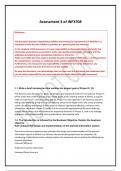Assessment 3 of INF3708
Disclaimer:
This document presents a hypothetical solution and working for Assessment 3 of INF3708. It is
important to note that this solution is provided as a general guide and reference.
As the recipient of this document, it is your responsibility to thoroughly review and verify the
information presented to ensure that it meets your specific requirements and aligns with the
guidelines provided by your educational institution or instructor.
While every effort has been made to provide accurate and reliable information, I cannot guarantee
the completeness, accuracy, or usefulness of the solution presented in this document.
Furthermore, I do not assume any responsibility or liability for the marks obtained or any
consequences that may arise from the use of this solution.
By using this document, you acknowledge that you have read this disclaimer and understand that
you are solely responsible for your own work and the marks obtained in your assessment.
1.1. Write a brief introduction that outlines the project goal of Project X. (2)
This business case discusses the goals, advantages, and important factors for carrying out Project X,
which entails the creation and setup of a tablet-based smart ordering system at Grilloo, a popular
eatery in Cape Town's central business district. Project X's main objective is to improve customers'
eating experiences by giving them quick and easy access to the digital menu and a way of making
orders. By utilising technology, Grilloo hopes to improve operational efficiency, enhance client
satisfaction, and foster a sense of loyalty. For the successful deployment of the smart ordering
system, this business case will examine the important elements of Project X, such as its strategic
alignment, anticipated benefits, cost considerations, and potential risks.
1.2. The introduction is followed by the Business Objective. Explain the business
objective
that underpin the design and implementation of the planned information system
The primary business objective that underpins the design and implementation of the planned
information system at Grilloo is to enhance the overall dining experience for customers. By
introducing a tablet-based smart ordering system, the restaurant aims to achieve the following key
business objectives:
Improved Efficiency
Enhanced Customer Experience
Increased Order Accuracy
, Menu Flexibility and Personalization
Data Collection and Analysis
The Business Objective session is followed by a section called Critical Assumptions
and
Risks. Describe the critical assumptions and risks of Project X. (10)
Assumption: Adequate infrastructure and technical support exist: The successful implementation of
Project X assumes that Grilloo has the necessary infrastructure to support the tablet-based smart
ordering system. This includes reliable power supply, stable wireless connectivity, and appropriate
network capacity. Additionally, it assumes that the restaurant has the technical support required for
maintaining and troubleshooting any issues that may arise.
Assumption: Customer adoption and acceptance: Project X assumes that Grilloo's customers will
readily adopt and accept the tablet-based ordering system. There is an assumption that customers
are comfortable using technology and will find value in the convenience and efficiency it offers.
However, it is crucial to consider potential resistance from certain customer segments, especially
those less familiar with technology or those who prefer traditional ordering methods.
Risk: System reliability and stability: The smart ordering system relies on the tablets functioning
smoothly and consistently. There is a risk of technical glitches, hardware failures, or software bugs
that could disrupt the ordering process or lead to customer dissatisfaction. Adequate testing, quality
assurance measures, and ongoing maintenance protocols are necessary to mitigate this risk.
Risk: Data security and privacy: The tablet-based system involves the collection and storage of
customer data, including personal information and order history. There is a risk of unauthorized
access, data breaches, or privacy violations if appropriate security measures are not in place.
Ensuring robust data encryption, secure network connections, and compliance with data protection
regulations is crucial to mitigate this risk.
Risk: Maintenance and support challenges: Installing tablets at each table requires ongoing
maintenance and support. The risk involves potential issues such as battery life, physical damage, or
device malfunctioning due to frequent customer use. The associated costs and challenges of
maintaining and replacing tablets as needed should be carefully considered.
Risk: Customer experience and usability: While the tablet-based ordering system aims to enhance
the customer experience, there is a risk that the technology may be perceived as complex or difficult
to use. Usability issues, lack of clear instructions, or an unintuitive user interface could lead to
frustration among customers. Regular user testing, intuitive design, and clear instructions are
essential to mitigate this risk.




